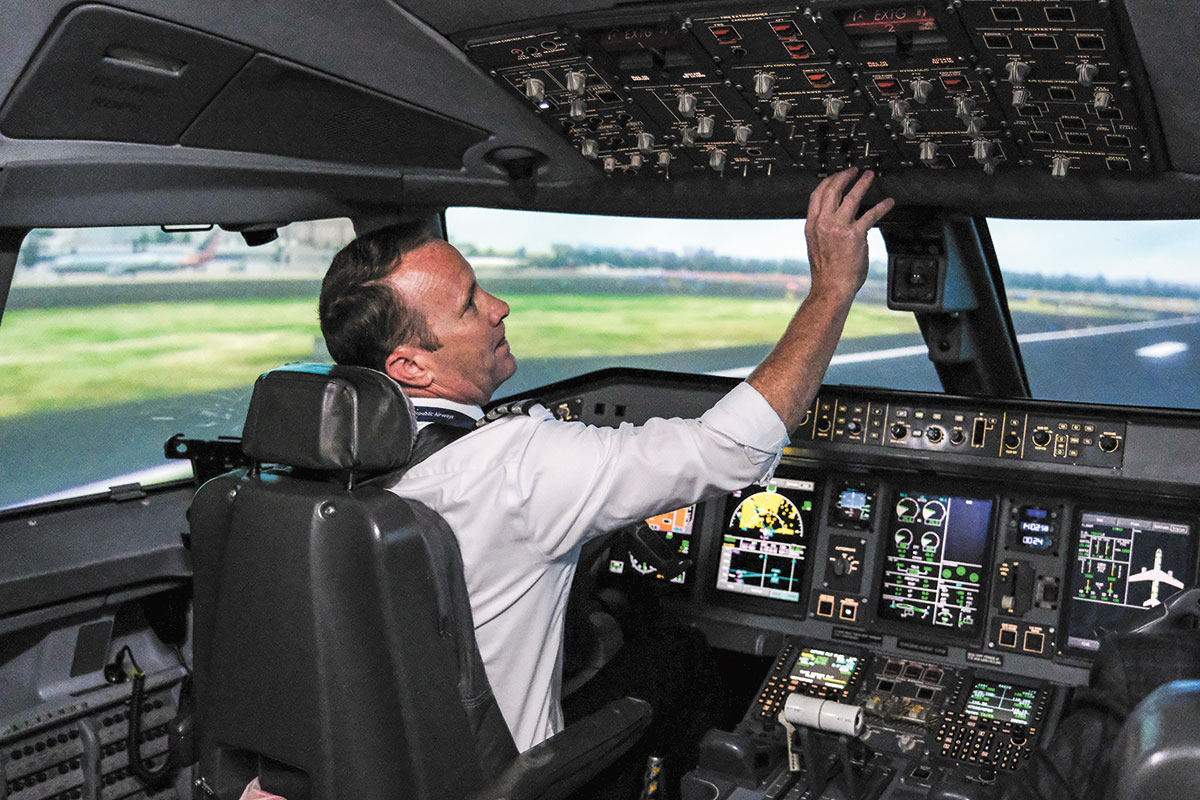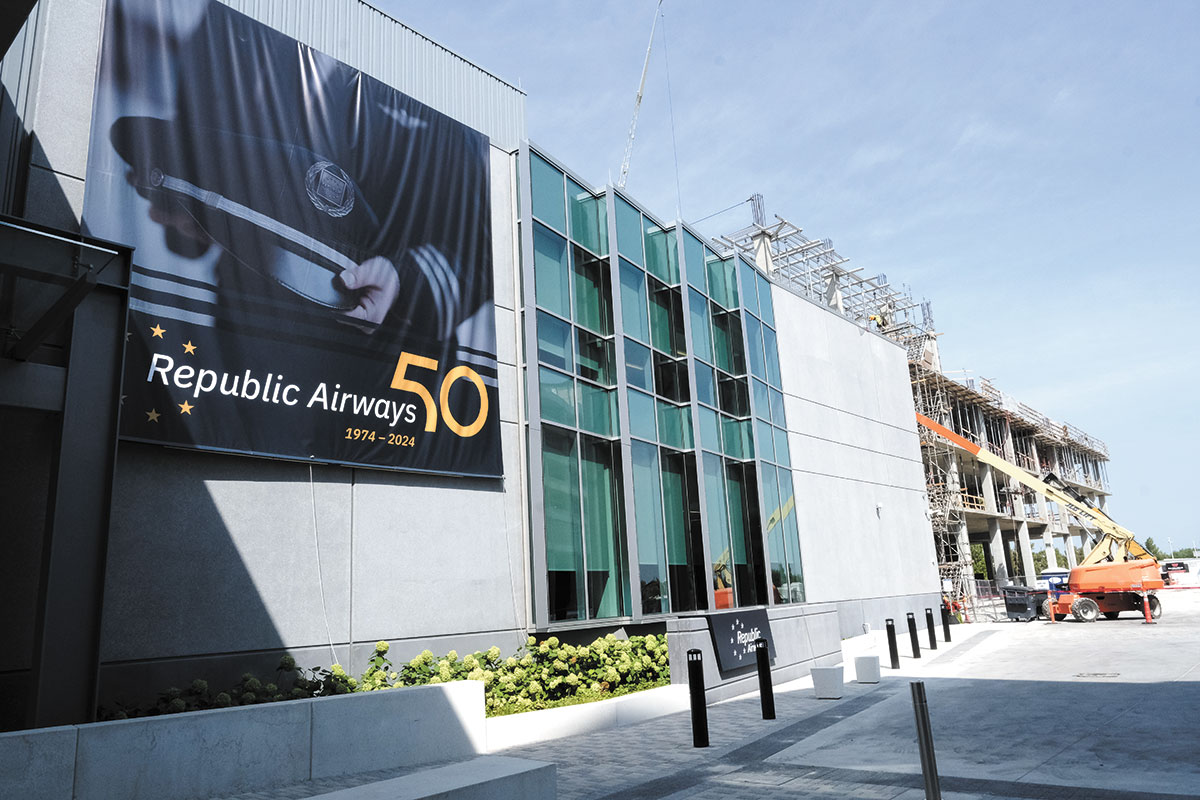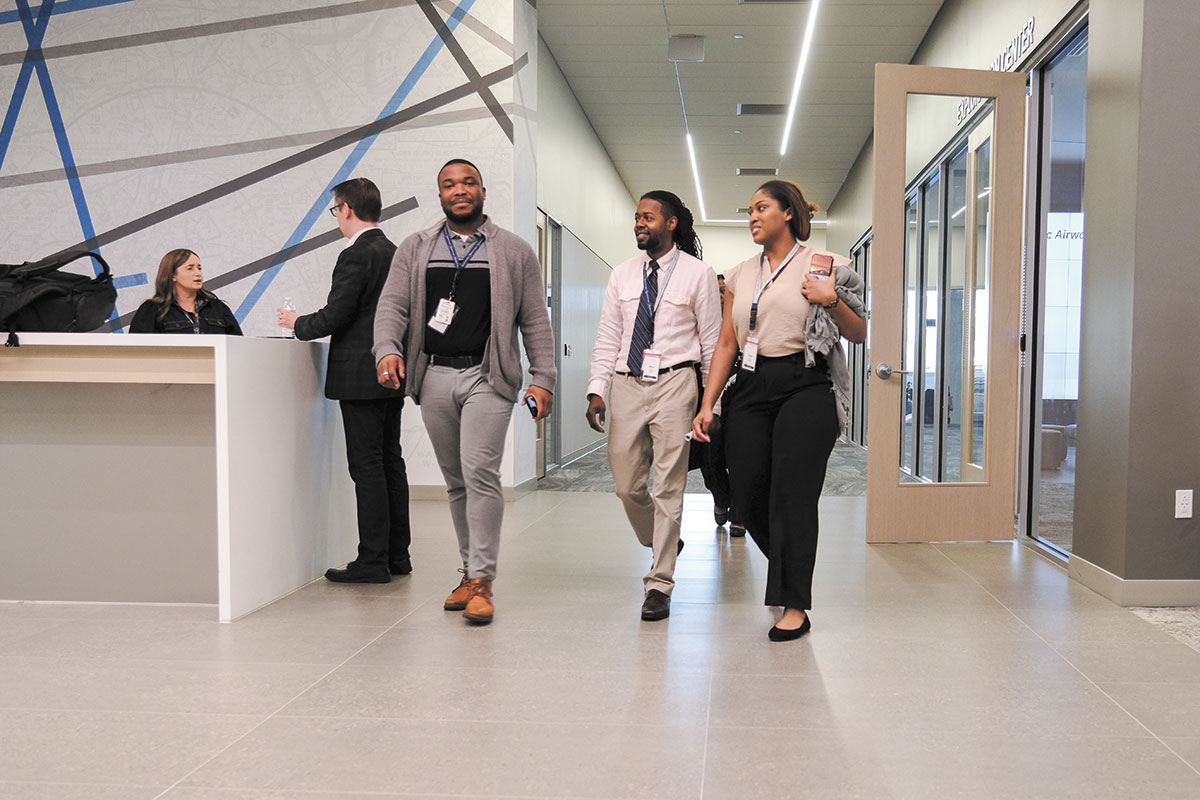Subscriber Benefit
As a subscriber you can listen to articles at work, in the car, or while you work out. Subscribe Now
Captain Michael Droese makes his final checks, and he is ready for takeoff from Ronald Reagan Washington National Airport. As Droese guides the plane along the runway, the Washington Monument is visible ahead, and the plane lifts from the ground.
But Droese is not in Washington, D.C., and he is not in a plane. He is in Carmel at Republic Airways’ new training center, where he navigates a flight simulator with a full cockpit and a view and experience that mimic an actual flight.
The training center, which houses eight full-motion flight simulators with room for two more, is part of Republic Airways Holdings Inc.’s new $200 million corporate campus between U.S. 31 and North Pennsylvania Street.
The 105,000-square-foot training center, a 272-room hotel used exclusively by Republic employees and an 800-space parking garage opened in April 2023. Republic’s 122,000-square-foot headquarters building is under construction and expected to open in January 2026.
“This is just sort of that next logical expression of, ‘We’re building a very strong future for Republic Airways,’” CEO Bryan Bedford told IBJ. “I think this facility, it’s a very tangible, visual expression of, ‘OK, we’ve got a strong future ahead of us. We’re investing in our future.’”

Along with the eight flight simulators built and maintained by Erlanger, Kentucky-based FlightSafety International, the training center also features eight flight-training devices that help new flight students learn the motor skills of operating a plane, a training room with an airplane cabin for flight attendants, a training area for maintenance technicians, 18 classrooms, and the Exploration Room, which is used to introduce visiting children to the airline industry with virtual-reality systems and interactive multimedia kiosks.
“The training is very difficult, but having a facility like this shows Republic’s attitude towards training, which is, it’s very important, and we want to do the best,” Director of Flight Training Andrew Petry said.
Republic and the city of Carmel announced in September 2021 that the regional airline would relocate its Indianapolis headquarters and consolidate its flight simulators that were in Cincinnati and St. Louis.
Republic’s campus is on the southern half of a 14-acre property that previously was occupied by the Hamilton Crossing retail center. Indianapolis-based Kite Realty Group Trust owned the Hamilton Crossing property and is managing redevelopment of the site, which is expected to eventually include multifamily housing and retail space attached to the parking garage.
Bedford said Republic worked for several years on an “expansive vision” for its new campus. The company looked at downtown Indianapolis; Columbus, Ohio; and Louisville before beginning “casual conversations” with former Carmel Mayor Jim Brainard.
Carmel was not initially in the top three, but Bedford said the Hamilton County city quickly became the clear choice. The Carmel City Council three years ago approved a tax-increment-financing bond of up to $49.5 million for the project, which is about 8 miles from Republic’s existing headquarters at 8909 Purdue Road on the northwest side of Indianapolis.
“Everything just sort of lined up,” Bedford said. “I just kind of felt like Providence was moving us in this direction.”
Carmel has more than 125 corporate headquarters, and Republic’s campus is among the city’s largest. It is visible to thousands of drivers a day who make their way north and south along U.S. 31, which can only help the city in its quest to add more companies to its portfolio, according to Mayor Sue Finkam.
“We love the marquee names like Republic Airways being in our corridor where it’s super visible and people see, ‘Well, if Republic chose Carmel, then maybe my business should, too,’” she said.

Major player
Republic has more than 6,000 employees, which includes 2,000 pilots, 2,000 flight attendants, 600 maintenance technicians and 300 systems operations control associates who handle dispatch and crew scheduling.
The company, which became privately held in 2017 after it emerged from bankruptcy, was the second-largest regional airline in the United States in 2022, according to the Regional Airline Association’s 2023 annual report. Republic flies a fleet of 221 76-seat Embraer 170 and 175 planes. St. George, Utah-based SkyWest Airlines was the largest, with 491 aircraft.
Regional airlines connect cities that lack sufficient demand or infrastructure to support flights from major airlines’ larger planes, like the Boeing 737, that operate between hub airports. In 2022, about 45% of the flights that took off from Indianapolis International Airport were handled by regional airlines, according to the RAA.
Republic partners with Fort Worth, Texas-based American Airlines, Atlanta-based Delta Air Lines and Chicago-based United Airlines to transport travelers on nearly 1,000 flights a day to destinations on the East Coast, such as Boston Logan National Airport; John F. Kennedy and LaGuardia airports in New York; Newark Liberty International Airport in Newark, New Jersey; Philadelphia International Airport; and Ronald Reagan Washington National Airport.
“Those are probably the most difficult airports and airspace environment to operate in the world,” Bedford said. “So, we feel like we really do have to have the best aviators to maintain what has been a 50-year legacy of perfect passenger safety operation.”
Overcoming challenges
Hiring the best aviators is a challenge, given the pilot shortage affecting every airline and the resulting competition for talent with major airlines, which can pay higher salaries. Bedford said Republic is operating about 80% of the flights it could fly if it had a full slate of pilots.
“I mean, it has just been a real bear,” he said. “It’s about 400 captains short of what we would normally like to see.”
Due to several factors, including the pandemic and an increasing number of pilots reaching the mandatory retirement age of 65, the North American airline industry in 2022 was about 8,000 pilots short of meeting demand, according to New York-based management consulting firm Oliver Wyman. The industry could reach a shortage of 30,000 pilots by 2032.
Regional airlines have been hit especially hard by the shortage. RAA CEO Faye Malarkey Black said regional airlines have contracted and took 27% fewer passengers in 2023 than they did in 2019, with 6% fewer daily departures.
She added that Arlington County, Virginia-based Boeing’s delivery delays of its 737 Max aircraft have also led to the recent slowdown in hiring. And she said federal policies and regulations add costs and limit access to pilot careers.
“A healthy regional industry is always going to depend on a healthy pipeline of well-trained pilots entering the profession, and airlines are focusing considerable support toward our future workforce,” she said.
Bedford said the pilot shortage means Republic must be creative in figuring out how to reach people who might not otherwise consider the industry.
“We were having no trouble getting traditional families interested in aviation for their children,” he said. “How were we going to increase the pilot catchment? Well, we had to make it an affordable opportunity to train kids who otherwise never would have had an opportunity to pursue the vocation.”

Different paths
While most new pilot students at Republic are in their early-to-mid 20s, Droese, 50, took a non-traditional path to earning his wings.
In 2021, he left his career in the finance industry to attend Republic’s subsidiary flight school, called LIFT Academy, at Indianapolis International Airport. Republic opened LIFT Academy in 2018 as part of the company’s strategy to attract prospective pilots from under-represented backgrounds.
“I’d always been fascinated with airplanes and airports and how it works,” Droese said. “And being here locally, with Republic being here and the flight school opening, it just made for a good thing.”
Malarkey Black said major airlines are following Republic’s lead in creating airline-based pilot-training academies, which shift costs from aspiring pilots to the airline that is hiring them.
“This goes well beyond expanding supply; it creates opportunities and outreach to populations that have been traditionally underrepresented in aviation,” she said. “This also gives the airline the unique ability to train pilots to their standards from Day 1 on relevant scenarios and in relevant equipment for a safer and stronger aviator.”
The Federal Aviation Administration requires pilots to accumulate 1,500 hours of training before they can fly commercial aircraft. Droese’s initial training took 95 days to complete, and he later received an additional 45 days of training to be promoted to captain. About 94% of students become Republic pilots.
“They really did make a very significant effort at the flight school to prepare you to sit in this seat here at Republic,” Droese said from the captain’s seat in the flight simulator. “The training methodology that you really start from Day 1 translates very well over the company.”
He and other Republic pilots must visit the training center in Carmel for one week twice a year to receive training updates. There are 250 people training every day at Republic, with flight simulators operating 20 hours a day, seven days a week. The facility is booked at 90% in case someone is sick and needs more time to finish.
While Droese lives in Zionsville, he said having the hotel adjacent to the training center makes life easier for pilots, crew members and new students.
“It just makes it very seamless,” he said.
Petry said the training center allows pilots and crew members to interact and gain skills they can use in stressful real-life situations.
For example, flight simulators can replicate a crisis, such as the 2009 flight when U.S. Airways pilots had to make an emergency landing in the Hudson River in New York. Flight attendants also train in a cabin that simulates smoke and heavy turbulence and learn self-defense tactics by using dummies in case they have to fend off unruly passengers.
“We joke that Republic is quickly becoming a training organization that happens to fly airplanes,” Petry said. “Having all of our resources in one place helps us be more efficient with those resources.”
Now that Republic can train all its pilots and crew in one place, Petry said people get to know one another better before they work together at 35,000 feet.
“The more we can get them interacting, the better it is for the outcome of the flight. And so that’s what we’re always striving for,” he said. “The more we can incorporate that into their training, the more natural it is when they’re out flying the line to be able to use all those resources that they have available to them to get us from point A to point B safely.”•
Please enable JavaScript to view this content.



This is a great story and I love to see such an important training facility in the Indy metro. The airlines will see a significant portion of its experienced pilots, flight attendants and mechanics retire. A new generation of avionics employees are needed and this is a step in the right direction.